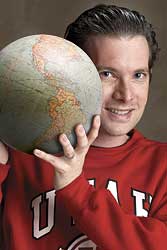
|
|
About Continuum Advertising Advisory Committee Archives Contact Us Continuum Home Faculty/Staff Subscribe related websites Alumni Association Marketing & Communications University of Utah Home |

Up frontOutpacing Our Imaginationsby Jason Matthew Smith, editor Among technophiles, there are a handful of infamous quotes from computer gurus and publications, savored for their ironic or archaic takes on technology and passed around like knock-knock jokes in a room full of 7-year-olds. Some of these quotes may be inaccurate or taken out of context, but they nonetheless develop an apocryphal life of their own. Often, they end up splashed across someone's home page or memorialized in 36-point Times New Roman and tacked above monitors in Computer Science departments worldwide. Some prime examples: "I think there is a world market for maybe five computers."- Thomas Watson, chairman of IBM, 1943 "Where a calculator on the ENIAC is equipped with 18,000 vacuum tubes and weighs 30 tons, computers of the future may have only 1,000 vacuum tubes and perhaps weigh one and a half tons."- Popular Mechanics, March 1949 "There is no reason for any individual to have a computer in his home." - Ken Olson, president, chairman and founder of Digital Equipment Corporation, 1977 Dubious authenticity aside, these amusing fragments generally serve two purposes: as a not-so-subtle reminder of how quickly computer technology can outpace your imagination, and as a kind of double-dog-dare tempting today's computer scientists to think beyond the here and now. University CS departments know that just keeping up won't cut it, and standing still risks obsolescence and irrelevance in about six minutes. They must decide whether to foster innovation and collaboration, or become an academic footnote. A few decades ago, the U's CS department (changed to School of Computing in 2000) chose the former-and far from fading from the scene, it has been waging a quiet revolution to make the same technology that gave us PlayStation put those bits and bytes to work in new and ever-more-useful ways. Kelley Lindberg traces the astounding legacy of the U's School of Computing , and examines innovations percolating in the school today that will have some real impact on our lives in years to come. And speaking of impact, our second feature looks at the world (and potentially the single most ominous threat it faces) through the eyes of an award-winning scientist. Lee Siegel's story on geophysicist David Chapman places us on the frontlines of the scientific and political squabbles over global warming, along with offering us a look at Chapman's life as a scientist, and how he takes personal responsibility to mitigate his own impact on the planet. Moving from a global scale to an intensely personal one, Chad Nielsen takes us along with AirMed, the U's air ambulance service, to rub shoulders with a team of dedicated medical professionals. Those of us working on campus often hear the helicopters whipping by overhead, rushing to a call or returning to University Hospital. Rarely do we give much thought to the human drama playing out a couple hundred feet above us, but Chad's story opens a window into that world. This issue also offers glimpses of a conspiracy theory expert and a guitar-plucking psychotherapist, among other surprises. So enjoy, and, in the meantime, check out Continuum's new Web site at www.continuum.utah.edu. |

|